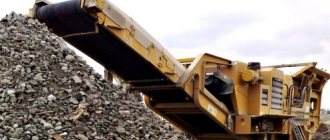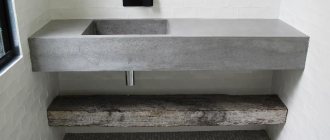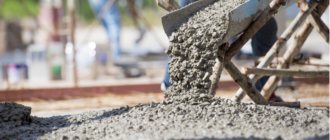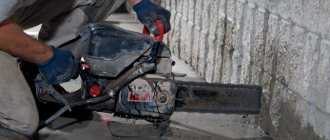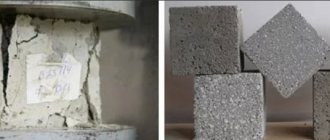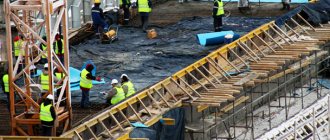Structure of heavy concrete of the test sample
The design compressive strength of concrete is one of the key characteristics that must be taken into account when designing any structure made from this material, and at the beginning of any construction. At the same time, it is necessary to pay attention to it not only to professionals, but also to ordinary craftsmen who have decided to build a house with their own hands.
Definitions
Strength is the main quality that accurately describes its load-bearing capacity. It is determined by the compression limit - this is the highest load limit at which failure of the sample occurs. And this is the main indicator that is taken into account when using it.
Design resistance is an indicator of a material’s resistance to loading influences. It is used in design calculations, and is integrally related to standard indicators of compression resistance.
Until the 2000s, they focused only on grades of material, which were taken as a design indicator, but according to new technical documents, each grade was assigned a new criterion for the sample’s compliance with compressive loads.
It was identified in laboratory conditions, legalized by specialists and reflected in SP 52−101−2003. According to this technical document, the standard resistance of a material to axial compression is the compression class specified with 95% certainty. The condition means that it is met in 95% of tested cases, and only in 5% can it deviate from the established indicators.
But even this percentage proves that using average calculated indicators when designing is unjustifiably risky. And when choosing the smallest value, the cross-section of the structure or product will increase, which in turn will affect the overexpenditure of money and energy resources.
According to SP 52−101−2003, standard resistance values are presented in the photo below.
Standard and calculated resistance values
There is also such a definition as tensile strength. By its nature, this material can withstand tensile loads much worse. That’s why it is reinforced in reinforced concrete products, thick floor screeds, foundations, etc.
When calculating, the compression indicator is used as a priority. In principle, any product or structure experiences heavy loads precisely from compressive static or dynamic influences. But resistance to bending influences is taken into account during design. In such cases, simply use the class correspondence table.
Table 6.7 from SP 63.13330.2012 SNiP 52-01-2003, which indicates the grades of resistance to compression and tension.
| View | Concrete | Standard resistances MPa, and calculated resistances for limit states of the second group and MPa, with a material class according to compressive strength | |||||||||||||||||||||
| B1.5 | AT 2 | B2.5 | B3.5 | AT 5 | B7.5 | AT 10 | B12.5 | B15 | IN 20 | B25 | B30 | B35 | B40 | B45 | B50 | B55 | B60 | B70 | B80 | B90 | B100 | ||
| Compression axial tension | Heavy, fine-grained and straining | — | — | — | 2,7 | 3,5 | 5,5 | 7,5 | 9,5 | 11 | 15 | 18,5 | 22 | 25,5 | 29 | 32 | 36 | 39,5 | 43 | 50 | 57 | 64 | 71 |
| Easy | — | — | 1,9 | 2,7 | 3,5 | 5,5 | 7,5 | 9,5 | 11 | 15 | 18,5 | 22 | 25,5 | 29 | — | — | — | — | — | — | — | — | |
| Cellular | 1,4 | 1,9 | 2,4 | 3,3 | 4,6 | 6,9 | 9,0 | 10,5 | 11,5 | — | — | — | — | — | — | — | — | — | — | — | — | — | |
| Axial tension | Heavy, fine-grained and straining | — | — | — | 0,39 | 0,55 | 0,70 | 0,85 | 1,00 | 1,10 | 1,35 | 1,55 | 1,75 | 1,95 | 2,10 | 2,25 | 2,45 | 2,60 | 2,75 | 3,00 | 3,30 | 3,60 | 3,80 |
| Easy | — | — | 0,29 | 0,39 | 0,55 | 0,70 | 0,85 | 1,00 | 1,10 | 1,35 | 1,55 | 1,75 | 1,95 | 2,10 | — | — | — | — | — | — | — | — | |
| Cellular | 0,22 | 0,26 | 0,31 | 0,41 | 0,55 | 0,63 | 0,89 | 1,00 | 1,05 | — | — | — | — | — | — | — | — | — | — | — | — | ||
The shear strength during chipping determines the resistance to compression and correlation indicators.
Note. Compression resistance B25 is the most commonly used indicator when designing a material.
Standard and design resistances of materials
The main strength characteristics of metal are tensile strength su and yield strength sy. Strength characteristics are determined by testing standard samples (round or rectangular cross-section) for static tension, recording a diagram of the relationship between stress s and relative elongation e (Fig. 1.6, a).
a) b)
Rice. 1.6. Tensile diagrams for steel samples:
a – low-carbon; b – low-alloy
Tensile strength is the ultimate resistance of a material to fracture, equal to the resolving load divided by the original cross-sectional area of the sample.
Yield strength is a normal stress, almost constant, at which the material yields (deformation under constant stress). The horizontal section of the diagram, called the yield plateau, for low-carbon steels is within the relative elongations from e = 0.2 to e = 2.5%.
For steels that do not have a yield plateau (low-alloy steels), the concept of conditional yield strength σ0.2 is introduced, the value of which corresponds to the stress at which residual deformation reaches ∆e = 0.2% (Fig. 1.6, b).
The ultimate resistance of steels is taken to be the yield strength or conditional yield strength, since with a further increase in load, excessive plastic deformations and unacceptably large displacements of structures develop. In cases where the structure is allowed to operate under the development of significant plastic deformations (for example, pipelines located in the ground), the temporary resistance can be taken as the ultimate resistance of steel.
The mechanical properties of materials are variable (they have a scatter of their values when testing standard samples), therefore state standards and technical specifications establish guaranteed limits for their change.
The main characteristics of the resistance of materials to force influences are the standard resistance to the yield strength Ryn and the temporary resistance Run.
The standard tensile, compression and bending resistance of steel Ryn and Run are taken, respectively, to be the lowest values of yield strength and tensile strength, guaranteed by GOSTs and established taking into account control conditions and statistical variability of the properties of steel produced by industry.
The provision of standard resistances for most construction steels is, as a rule, no less than 0.95, i.e. a metallurgical plant must guarantee that at least 95% of its products have a standard resistance exceeding the value established by GOST.
Possible deviations of strength and other characteristics of materials in an unfavorable direction from their standard values are taken into account by the reliability coefficients for the material γm.
In addition, the reliability coefficient for the material takes into account factors that can lead to a decrease in the actual strength characteristics and geometric characteristics of the sections compared to those guaranteed by the manufacturer:
– the value of the mechanical properties of metals is checked at factories by random tests;
– the mechanical properties of metals are controlled on small samples under short-term tension; in fact, the metal works for a long time in large-sized structures under a complex stress state;
– rolled profiles may have minus tolerances.
The reliability coefficient for the material γm is established based on the analysis of the distribution curves of the test results of steel and its performance in the structure. When supplying steels in accordance with GOST 27772-88 for all steels (except S590 and S590K) γm = 1.025; for steels S590 and S590K γm = 1.05.
When calculating structures using the design resistance Ru, established by the temporary resistance, the increased danger of such a state (approximation to the breaking stress) is taken into account, and an additional reliability factor γu = 1.3 is introduced.
The main design characteristic of steel is the design resistance, the value of which is obtained by dividing the standard resistance by the reliability coefficient for the material:
– by yield strength Ry = Ryn/γm;
– according to temporary resistance Ru = Run/γm.
studfiles.net
Axial compression. Calculations and values
When making calculations, it must be taken into account that class (B) directly depends on its average strength R, MPa. Accordingly, the following formula is used:
B = R (1−tV), where t is the security class included in the design, generally take the value 0.95, respectively t = 1.64; V – strength variation coefficient. 1 – constant.
If the standard coefficient V = 13.5% (0.135) was used in the calculations, then the average strength is equal to R = B/0.778.
It’s another matter when all kinds of reinforced concrete structures are calculated. The boundary height of the specified zone is calculated especially carefully. It expresses the height at which, before failure, the stresses in the compressed material and the tensile reinforcement reach their maximum values simultaneously. Only under this condition can the section be considered normally reinforced.
According to SNiP 2.03.01 - 84, the height of the zone is the formula:
Compressed zone height formula
In this case, the relative height of this zone (table) is used for a specific product. They can be found in regulatory documents, and the data can be used in calculations. Basically, the information provided briefly explained what the compression zone and axial compression resistance are.
LEGEND OF CHARACTERISTICS
| Standard resistance at normal voltage, MPa | Rnn |
| The same, with shear, MRa | Rqn |
| Design resistance at normal voltage, MPa | Rnd |
| The same, with shear, MRa | Rqd |
| Standard modulus of elasticity at normal stress, Mpa | En |
| The same, with shear, MRa | Gn |
| Calculated modulus of elasticity at normal stress, MPa | Ed |
| The same, with shear, MRa | Gd |
| Operating conditions coefficients: according to the regime with constant force | GT |
| by temperature | gT |
| by environmental influence | ge |
| by humidity | gew |
| Standard compliance at normal stress, Pa–1 | Dn |
| The same, with a shift, Ra–1 | In |
| Calculated compliance at normal stress, Pa–1 | Dd |
| The same, with a shift, Ra–1 | ID |
| Standard relative deformation of the thermoviscoelastic limit at normal stress | elim,n |
| Same with shift | glim,n |
| Standard relative deformation of the limit of linear thermoviscoelasticity at normal stress | epr,n |
| Same with shift | gpr,n |
| Calculated relative strain of the limit of viscoelasticity under normal stress | elim,d |
| Same with shift | glim,d |
| Calculated relative strain of the limit of linear thermoviscoelasticity at normal stress | epr,d |
| Same with shift | gpr,d |
| Maximum residual compliance under normal stress, Pa–1 | Dres,max |
| The same for shear, Ra–1 | Gres,max |
| Creep coefficient | dct |
| Recovery rate | drt |
| Temperature coefficient | dT |
| Environmental influence coefficient | de |
| Humidity coefficient | dew |
Methods for determining strength using control concrete samples
Having understood what the compressive strength of a material is, we will consider the main methods for determining this indicator.
Destructive testing of concrete
Compression testing is usually carried out in accredited construction laboratories using certified equipment. The main thing you need for it is a press.
Accurate laboratory scales, calipers and test specimens will also be required. The latter are prepared in advance from the required batch. The shape is standard - a cube with sides of 10 cm. According to technical documents, from 3 to 5 samples are used for one batch.
Advice. Initially, they need to be prepared by cleaning them from contamination and weighed to determine compliance with the density, weight and design grade of the material. If these values are normal, then you can be 95% sure of the proper level of stability.
The sample is placed on the press with absolutely even edges, turned on and testing begins. The maximum load at which the sample began to fail is the ultimate compression.
The average value is established based on the results of control of all selected samples. The final figure determines whether or not the actual strength corresponds to the standard and design values. After which it is entered into the journal.
Gallery: destructive testing process using a press.
More detailed instructions for testing concrete samples are presented in the video in this article.
Non-destructive testing
The previous method is required in any construction industry and at any stage of construction.
It is considered the most reliable:
- Designers and architects rely on the results of laboratory destructive research protocols when constructing buildings and manufacturing reinforced concrete products.
- When it is not possible to determine the strength of samples using a destructive method, or when repeated analysis of the characteristics is required after a certain time, special devices are used.
- They are necessary in order to test the material for compression directly on site. With one light touch they determine the numerical value and, if desired, other necessary characteristics regarding the uniformity and compaction of the material body.
- There is a lot of similar equipment, but the most common in construction circles is the IPS - MG device of various modifications. It is easy to use, accurate and affordable.
Photo of an automated device.
It is mainly used on construction sites. This electronic meter allows you to quickly determine density, strength and elastic-plastic properties using the shock pulse method. Although this method is not a priority, it is still provided for by GOST 22690.
Advice. Before “shooting” the concrete, it is imperative to select or prepare the surface. It must be smooth without roughness, dents, voids, cracks and other defects with an area of at least 100 cm2. If necessary, you need to sand the surface.
The number of sections must be accepted according to the test program, but there must be at least three. Typically, for a volumetric reinforced concrete structure, an average value of 15 samples is taken.
This amount depends on the area, since the control points must be at a distance of 15 mm from each other and at least 50 mm from the edge. Ideal places are between crushed stone granules and large shells in the concrete body.
To test the design, you must:
- turn on the device, and it will immediately be in test mode;
- enter data about the material being tested;
- cock the lever on the “pistol”;
- press firmly perpendicular to the surface being tested and release the lever;
- the result will appear on the scoreboard, it will be remembered for subsequent tests;
- after 15 samples, the average value is automatically displayed; if the number of “shots” is less, then you can view the average result in advance.
What’s good about such a device is that all the data on it can be saved on a computer and archived. You can review previous tests on your computer at any time and create a report.
Calculated resistance - material - Big Encyclopedia of Oil and Gas, article, page 1
Design Resistance - Material
Page 1
The calculated resistances of materials are used when calculating the strength of reinforced concrete elements. [1]
The calculated resistance of the material R is determined by dividing the standard resistance Ru by the safety factor for the material K, which takes into account a possible decrease in the mechanical properties of steel against the standard values, as well as minus tolerances on the size of rolled sections. [2]
In foundation bolts, a decrease in the calculated resistance of the bolt material compared to the nominal value is also explained by the fact that the degree of tension of adjacent bolts of the column base during the installation of the column can be different, and therefore, in reality, some overload of individual bolts is possible. [3]
Using reference books or standards, the calculated compressive resistance of the material R is determined, if it is not specified. [4]
A decrease in the vibration strength of a connection is taken into account by reducing the design resistance of the material (see Chapter [5]
The product R - k is sometimes called the design resistance of the material. [6]
The section of the sheet pile is determined by the maximum bending moment and the calculated resistance of the sheet pile material to bending. [8]
The design bearing capacity of a structure is determined not by the standard, but by the calculated resistance of the materials, therefore it is the smallest probable value of the bearing capacity at which the proper strength of the structure is guaranteed. [9]
Depending on the valve group and the selected grade of steel 13), the calculated resistances of the material and welded joints are determined. When determining the design resistances, the coefficient of operating conditions (see § 3.1) and the coefficient of transition to derivative resistances during bending, p-equal to 1 05, taking into account the possible limited development of plastic deformations, are taken into account. [eleven]
The effects of longitudinal forces on the base metal are also perceived by the butt weld, therefore the calculated resistance of the element material must be equal to the calculated resistance of the deposited metal. If this condition is not met, then the welded joints are checked for strength. [12]
When performing strength calculations of tanks, correction factors are used for loads, impacts and design resistances of materials, provided for by several regulatory documents. [13]
When using deposited metal in butt welds, the design resistance of which is lower than the design resistance of the material of the elements being welded, the welds can be made straight or oblique. [14]
When performing strength calculations of tanks and gas tanks, correction factors are used for loads, impacts and design resistances of materials. Since seismic calculations also take into account static loads, the full calculation is carried out for a special combination of loads. Some coefficients are provided for by several regulatory documents, so their relationship should also be taken into account. [15]
Pages: 1 2 3 4
www.ngpedia.ru
Other characteristics of concrete
Compressive strength is not an independent characteristic. It, like others, depends on many circumstances and other properties of the material.
What determines the strength of concrete?
Main factors:
- quality of components, namely, activity and strength of cement, cleanliness and correct choice of aggregate size modulus, chemical composition of water, correct selection of plasticizing additives;
Components of heavy concrete
- optimal selection of composition that meets the main motto of reinforced concrete technologists: “maximum quality at minimum cost”;
- body-humidity regime of product processing;
- accuracy of testing samples in the laboratory;
- correct algorithm for stress relief of concrete products;
- subsequent aging of products under certain conditions.
Cracks are a sign of low-quality concrete
If, when measuring strength, the compression grade actually turns out to be much lower than the standard, be sure to reconsider the quality of the product according to the above points in order to identify the cause of the defect.


